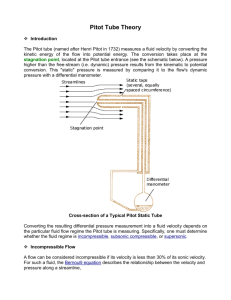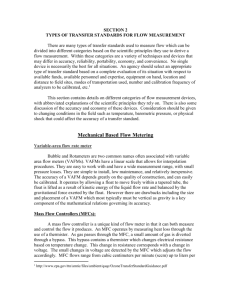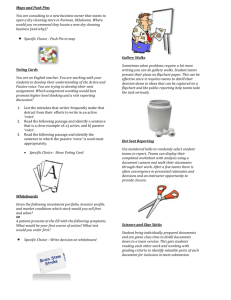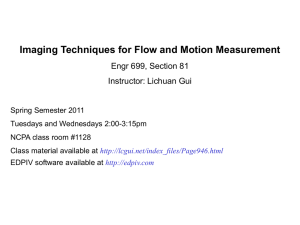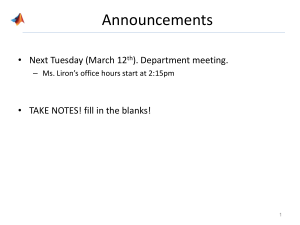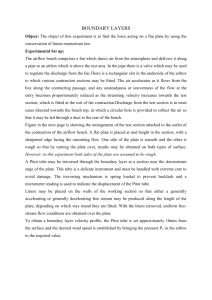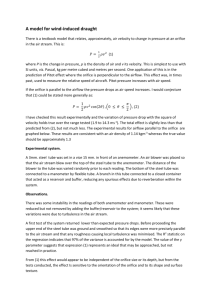Henry Pitot (1356), Index
advertisement
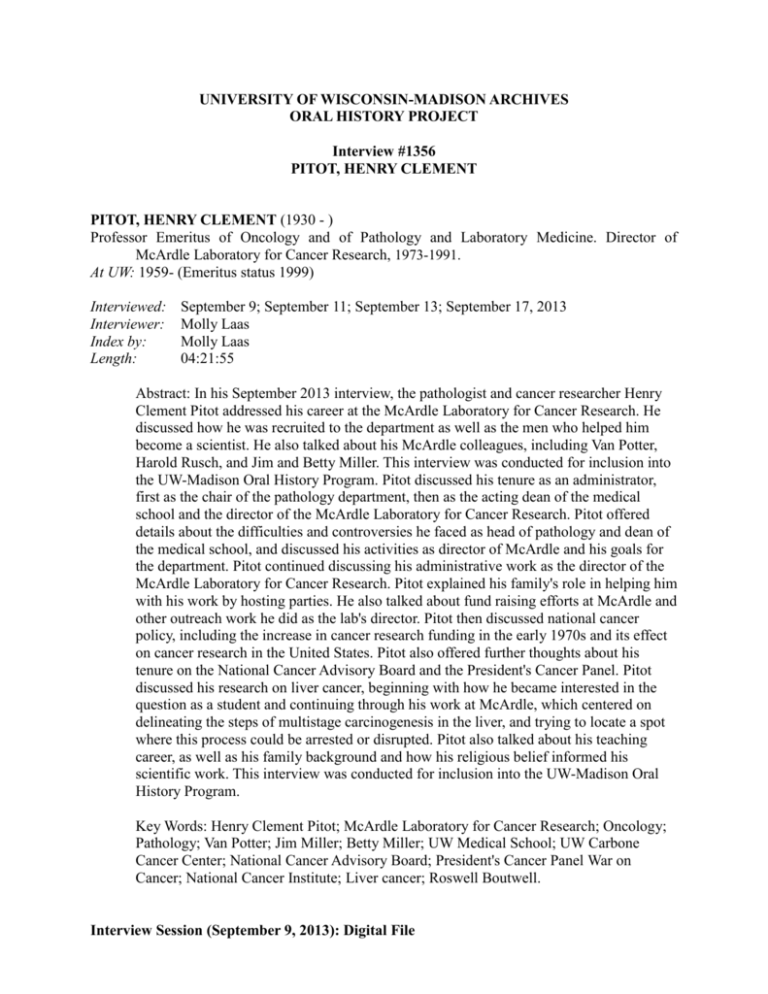
UNIVERSITY OF WISCONSIN-MADISON ARCHIVES ORAL HISTORY PROJECT Interview #1356 PITOT, HENRY CLEMENT PITOT, HENRY CLEMENT (1930 - ) Professor Emeritus of Oncology and of Pathology and Laboratory Medicine. Director of McArdle Laboratory for Cancer Research, 1973-1991. At UW: 1959- (Emeritus status 1999) Interviewed: Interviewer: Index by: Length: September 9; September 11; September 13; September 17, 2013 Molly Laas Molly Laas 04:21:55 Abstract: In his September 2013 interview, the pathologist and cancer researcher Henry Clement Pitot addressed his career at the McArdle Laboratory for Cancer Research. He discussed how he was recruited to the department as well as the men who helped him become a scientist. He also talked about his McArdle colleagues, including Van Potter, Harold Rusch, and Jim and Betty Miller. This interview was conducted for inclusion into the UW-Madison Oral History Program. Pitot discussed his tenure as an administrator, first as the chair of the pathology department, then as the acting dean of the medical school and the director of the McArdle Laboratory for Cancer Research. Pitot offered details about the difficulties and controversies he faced as head of pathology and dean of the medical school, and discussed his activities as director of McArdle and his goals for the department. Pitot continued discussing his administrative work as the director of the McArdle Laboratory for Cancer Research. Pitot explained his family's role in helping him with his work by hosting parties. He also talked about fund raising efforts at McArdle and other outreach work he did as the lab's director. Pitot then discussed national cancer policy, including the increase in cancer research funding in the early 1970s and its effect on cancer research in the United States. Pitot also offered further thoughts about his tenure on the National Cancer Advisory Board and the President's Cancer Panel. Pitot discussed his research on liver cancer, beginning with how he became interested in the question as a student and continuing through his work at McArdle, which centered on delineating the steps of multistage carcinogenesis in the liver, and trying to locate a spot where this process could be arrested or disrupted. Pitot also talked about his teaching career, as well as his family background and how his religious belief informed his scientific work. This interview was conducted for inclusion into the UW-Madison Oral History Program. Key Words: Henry Clement Pitot; McArdle Laboratory for Cancer Research; Oncology; Pathology; Van Potter; Jim Miller; Betty Miller; UW Medical School; UW Carbone Cancer Center; National Cancer Advisory Board; President's Cancer Panel War on Cancer; National Cancer Institute; Liver cancer; Roswell Boutwell. Interview Session (September 9, 2013): Digital File Henry Clement Pitot (#1356) Time Keywords 00:00:00 Start of Interview/Interviewer’s Introduction. 00:00:11 Question: Why did Pitot come to McArdle as a postdoc? Answer: Henry Pitot (HP) explained that he got his bachelor's degree in chemistry at Virginia Military Institute, and an organic chemistry professor there required that students do research. This gave him an interest in biochemistry, and he was told that he had to go to medical school in order to learn it. Pitot went to medical school at Tulane University (1951-55). Pitot said that during his first year of medical school he almost quit because he did not like rote learning. However, he met Emmanuel Farber, a pathologist who allowed HP to work in his laboratory and introduced him to the study of liver cancer. In the summer between his first and second year of medical school Pitot doing research with Ernest Kun, who was a visiting professor at Tulane, and the synthetic organic chemist Joe Dechary. Pitot said that he would like to study how disease mechanisms work. Kun told HP about McArdle. Farber suggested that he get his MD and then learn biochemistry after that; in the meantime he could train in pathology. Pitot said that this seemed like a good plan to him though he did not think too much about what it might involve. Farber suggested that he apply for a fellowship to support Pitot and his wife; Pitot applied for and received an American Cancer Society fellowship. After he graduated he went right into pathology, skipping an internship. He took primarily physical chemistry and advanced organic chemistry, as there were not too many organic chemistry courses at Tulane. He received his doctorate in biochemistry in 1959 and had completed his requirements in pathology. HP began to be interested in Van Potter's work, and met him at an American Cancer Society meeting in 1959. Potter became interested in HP's work, and invited him to apply to become a postdoc. At that point Pitot had four children and one on the way, he said, and so the family came to Madison and rented an apartment. Pitot worked in Potter's lab and his wife Julie took care of the children. Pitot said that his lab was one of the first to begin studying new types of transplantable cancers. Potter became interested in his work, and he and Rusch offered him a faculty position. At this point, UCLA was interested in hiring him, and Tulane wanted him to come back. Pitot related going to an interview for a fellowship in Virginia, when he narrowly missed taking a plane that crashed. Potter said he was very outspoken in these interviews and he was not chosen. He took a position at McArdle, on a lower salary than the one he received as a postdoctoral fellow. He said he had a number of other offers but he did not take them. 00:15:23 Question: Why didn't Pitot take those offers? Answer: Difficult to move with a large family. The only one that was interesting to him was Stanford, but they never offered him a position, which he said was because he had a larger family. Pitot said that some of the offered salaries were two to three times what he had at McArdle, though he noted that living expenses were greater at other places. 00:16:55 Question: What was Pitot's lab like when he first arrived? Answer: The lab and office were small [half the size of the small meeting room used for the interview]. He and Potter were close collaborators for the first 3-4 years. He received his own space when McArdle moved to its new building in 1964. Question: What was it like to work with Potter? Answer: Potter gave complete ownership of a project to his student. Henry Clement Pitot (#1356) He taught HP that kind of fairness. He was a scientific father to Potter, alongside Farber and his teacher at VMI. Question: How did HP's relationship with Potter evolve over time? Answer: HP said they became closer in some respects, but more distant in other respects, because their scientific interests diverged and they had different labs. Pitot said that the NCI Program Project Grant received by McArdle melded all of the institution's federal grants together, and Rusch gave more money to Pitot, increasing the size of his lab. Where Potter and HP differed was on spiritual matters, he said. HP is a devout Roman Catholic and Potter was an agnostic. HP characterized Potter's turn toward bioethics as a practical spirituality. 00:25:10 Question: Impressions of Harold Rusch as a director? Answer: Rusch's function was to make sure that all of the faculty did the best they could. Rusch got the current McArdle building built. His dream was the cancer center, [now Carbone Cancer Center] which he reached. Pitot speculated as to whether Rusch would agree with McArdle's planned move to the cancer center, and assumed that he would. HP said that Rusch's humility and dedication to the faculty made McArdle what it is, and he hoped that other directors kept this philosophy. HP said he tried to, as did Norman Drinkwater. HP said that some parts of McArdle have not changed for the better, such as the possibility of having joint appointments where the primary appointment was McArdle, as Pitot said he had. McArdle used to be more a tightly-knit community under Rusch, he said. Pitot noted that Howard Temin and Waclaw Szybalski began at McArdle at the same time. HP noted that the university had moved slowly in getting Temin an acceptable laboratory, as the facilities managers were overworked and could not get things done on time. HP discussed Temin's work on the Rous sarcoma virus, what was then a new area of research, and for several years he had no publications. HP said that he became an associate professor a year before Temin did, but Rusch still supported him. 00:33:33 Question: What was it like to work with Waclaw Szybalski? Answer: Pitot worked with one of Szybalski's people, a cell culture expert, so this was his closes association with Szybalski. HP noted that his expertise in molecular biology helped Pitot's group a number of times, though they did not have much interaction. Pitot noted that there was a moment when liver cancer was a particular focus on many of the workers at McArdle. Temin then came out with some seminal papers about the metabolism of Rous sarcoma-infected cells, and then his reverse transcriptase work [for which Temin won the Nobel Prize in 1975] which was initially not accepted. HP speculated that David Baltimore [who co-won the Nobel with Temin and Renato Dulbecco] had heard Temin give a presentation and then tried to verify Temin's ideas with similar experiments. Pitot reminisced about Temin calling him early in the morning to tell him that he won the Nobel. 00:38:20 [No question] The closest people that he worked with were Jim and Betty Miller, for whom he read their slides. Prior to this, the Millers sent their slides to the State Laboratory of Hygiene, a process that took several months and was expensive. For them it was nice to have someone who could read the slides. This meant that they had to develop a histotechnology laboratory. HP said that a friend of his in Chicago told him about a histology technician, George Pridmore for a pathologist named Otto Saphir at the University of Chicago. The technician had come to Madison and was looking for a job, and McArdle hired him, in about 1965. Pitot said he was very Henry Clement Pitot (#1356) skilled, because he was trained by a master. Pridmore maintained the lab's electron microscope as well. Pitot then explained the collaborative work he did with the Millers, and discussed Betty Miller, who he described as humble as well as an extremely exact scientist, who expected accuracy from her graduate students and postdocs. Pitot explained that Rusch was the editor of the American Journal for Cancer Research and Ilse Riegel [on McArdle's scientific staff] was the publication's the managing editor. Betty Miller was also a member of the editorial board, and had an extremely good knowledge of how to publish a scientific paper. Pitot said she had been maligned when she was training at UW; she ended up in home economics because the biochemistry department was only taking male students. She was even turned down for a fellowship even though she was the best student. Pitot said she could have become bitter about this, but did not. She ended up getting a major professor in the biochemistry department and a degree in biochemistry. She was an associate professor until the late 1960s, which Pitot described as absurd because she was doing important work. Pitot said that the Millers worked together very well. Jim was more staid than Betty, Pitot said. Pitot said that every week he and Betty would discuss the department before staff meetings [Betty Miller was the assistant director of McArdle when Pitot was the director]. Pitot said Betty's diagnosis of [ovarian] cancer saddened him deeply, as a pathologist he knew the prognosis wasn't good. 00:49:22 Question: Relationship with Roswell Boutwell? Answer: Pitot discussed Boutwell and Gerry Mueller together, as they were very close. He said that he didn't think that they supported his being made an assistant professor, as he was an outsider and too young. Pitot said they became closer later. Pitot said that Mueller was brimming over with ideas, most of which he couldn't follow up on. Pitot said that he, Boutwell and Mueller would room together when they went to meetings. When he was going to become director, Pitot went around to talk to all of the faculty members and Mueller seemed a bit hesitant. Pitot then discussed how his work on multi-stage liver cancer in the 1970s had similarities with Boutwell's work on skin cancer. 00:53:56 Question: Work with Heidleberger? Question: Pitot said he gave a talk at a journal club about François Jacob and Jacques Monod's work on the feedback mechanisms for gene expression and how it might relate to cancer. Heidelberger suggested that they publish these ideas, which they did. The paper was a theoretical one, but was very widely circulated; Pitot said he didn't know why it was popular, except for the fact that it was a way for cancer researchers to connect their work with what was being done in bacterial genetics. Pitot said that Heidelberger and his first wife were very sociable. 00:56:55 Question: Support staff? Answer: Helen Iverson [business manager of McArdle] and Reigel were important to Pitot's work. Iverson and Pitot worked closely together while he was director. Pitot noted that Iverson and her husband owned a bowling alley, and Pitot, and his wife would bowl at their alley, and then sit and chat. Pitot said that Iverson was able to keep all the scientists at McArdle reasonably happy, which he described as a feat. Iverson also developed ovarian cancer; Pitot described her reaction to the treatment; he said he was sad to see her suffer. HP noted that Iverson had asked him what it was like to die, as a physician she thought he should know; he could not answer the question. Pitot said that Reigel would help him with manuscripts. He said that she had a doctorate in zoology but knew a fair amount of Henry Clement Pitot (#1356) biochemistry and oncology. She and Betty Miller wrote the major grants for the department. Everyone would contribute but they would make it readable and presentable. They were very detailed and excellent grants. Pitot said he was blessed with an amazing team as director. 10:04:07 End of Interview Interview Session (September 11, 2013): Digital File Time Keywords 00:00:00 Start of Interview/Interviewer’s Introduction. 00:00:11 Question: Why did you become chair of pathology at the University of Wisconsin in 1968? Answer: Pitot explained that UW's pathology department was quite old fashioned, and isolated from clinical pathology. Surgical pathology was initially part of the department of medicine, not part of pathology proper. Pitot said he was offered the chair of the pathology department at Yale University as well as at UW; the attraction for UW was that he would be able to keep his laboratory at McArdle. He intended to be chair for about three years to build up the department, give it a national profile, and integrate the clinical labs with the department of pathology. The department of medicine did not like this, and Pitot compromised by requiring that the head of the clinical labs be part of the department of pathology. This happened in 1972-73. HP said that he maintained his laboratory because he had some outstanding postdocs who ran the lab while he took care of administrative duties. Pitot said that the pathology department brought in a neuropathologist to build the pathology department's house staff program, which he did by hiring a number of osteopaths for the residency program. One of these students, George Michalopoulos, became Pitot's graduate student. Pitot discussed how the pathology department became more deeply involved with its service role, including doing autopsies for the city of Madison's coroner's office after hiring a forensic pathologist. Prior to this the coroner was the forensic pathologist for the city, which Pitot said meant that it was literally possible to get away with murder, as the coroner had a limited budget for doing autopsies and would not spend his money on it. Pitot reminisced about a murder-suicide in town involving six people, and the pathology department did the autopsies for him. The advantage of this was that the department earned money for doing this work. Pitot explained that UW did pathology for most of the state, except for Milwaukee, which had its own medical examiner. He described some of the other recruits to the pathology department, including a renal pathologist and a woman named Enid Gilbert, a pathologist and pediatrician, who was a visiting professor. Her husband was on a fellowship at UW and is now a physiologist at Madison. 00:17:13 [No question] Pitot detailed his efforts to leave his position as the chair of the pathology department without getting in trouble with the dean, as he had only stayed for three years. He said he took what he thought was the easy way out when he became the acting dean of the medical school [in 1971]. Pitot said he would take the job for a year. He said that a lot of the deans of medical schools in the U.S. are pathologists because they straddle the divide between basic and clinical science. Pitot said that there was a push to keep the medical school on campus versus a push to Henry Clement Pitot (#1356) move it to its current location. Pitot said he was against it because it was a very expensive proposition, around $60 million in 1970. The state would come up with a portion of the funding, and there was a grant proposal in with the federal government would pay $10 million. He said that it was not a sure thing that UW would get the grant. The state was willing to put money in if the federal grant came through; the rest of the funding would come from state bonds. When UW got the federal grant the state came through with less than expected. The medical school campus was built for about $40-50 million, he said. Construction began while Pitot was still acting dean. This question was a big part of his deanship. The other one was a push in the state to train more primary care physicians. There was a family physician residency at UW, which had a preceptorship program as well, which dated from the 1920s. There was resistance to starting a department of family medicine with its own residency program. Pitot said that the medical school was very conservative, and there was a bitter fight between medicine and surgery at the time as well, about the much greater salaries enjoyed by surgeons. In addition the chairman of surgery was against the other aspects of the medical school. Pitot said that he arranged for him to have a position in the chancellor's office with more money and more prestige, in order to bring in a new chairman of surgery, Folkert O. Belzer, who mended fences. 00:29:14 [No question] Pitot narrates how he became McArdle's director. McArdle chairman Harold Rusch was one of the members of President Richard Nixon's committee to set up cancer centers across the country, and he began to dedicated himself to obtaining one for Wisconsin. Pitot said that the McArdle faculty told Rusch that he couldn't be the head of the department if he was going to work on the cancer center full time. He explained that Rusch's ultimate goal was to bring McArdle and a clinical center together as a unit. The department then voted on who their next director would be. Pitot suspected that Rusch and McArdle scientist Van Potter nominated him, because he had administrative experience. He said that running McArdle takes a scientist, not an administrator. He said that all of the faculty agreed that he should be director. So Pitot stepped down as acting dean of the medical school and became McArdle's director, with Betty Miller as the associate director. 00:33:53 Question: How did Pitot split his duties with Miller? Answer: Pitot explained that he was the “talker” and Miller was the “doer.” She interacted with the faculty members and take the pulse of the department. They met once a week to discuss how things were going. Miller also worked on grants. Pitot addressed Betty Sheehan, an administrator at McArdle who was sitting in on the interview, to ask her if she also worked on grants, which she had. Pitot said he tried to go on the national scene. He had been chairman of a training grant committee for the National Institutes of Health, and he worked on the National Cancer Advisory Board (NCAB) of the National Cancer Institute, and was chairman of it. This was important for the department, but took a lot of time, so Miller kept the department going while Pitot tried to keep McArdle's profile high at a national level. Pitot discussed the difference between the NCAB and the President's Cancer Panel, on which he also served. He said that it was not clear what the latter group did; he said that it was mainly for show. Pitot explained said once that the director of the NIH called Pitot in one day and asked him he was interested in being the NCI director and he told him no, he said this was a political appointment on the national level and this would mean stepping out of science. He said he was fortunate that he could keep up his laboratory while being the Henry Clement Pitot (#1356) director of McArdle, though not at 100%. Pitot returned to explaining his role at McArdle; he said there were a couple of times that things got testy in the department that was his responsibility to smooth it over; also he ran staff meetings. 00:40:52 Question: What were Pitot's major goals for McArdle while director? Answer: Pitot said that he got McArdle a new animal facility via a grant from the NCI. The advantage to this was that it was outfitted according to new workplace rules for working with carcinogens. Pitot noted that the fourth floor of the McArdle building was empty when it first built, to come within budget and allow for expansion. Pitot noted that Rusch did not allow joint departments in McArdle to keep cohesiveness, which kept the department together. He said that Dove eventually obtained a joint appointment in genetics, though he was not paid by that department. The same went for Pitot, though he did receive some money apart from his regular salary for being a practicing pathologist. 00:45:33 Question: Other goals for McArdle? Answer: Pitot explained that his main goal was to keep it as an outstanding research department. He said that there was once a dean who wanted a joint appointment in McArdle, which HP said he was against, as he wouldn't have a lab or a research program in the department. After Pitot stepped down and Norman Drinkwater took over (in 1991) then joint appointments increased. Question: challenges that faced you as a director? Answer: Pitot said that there was plenty of funding from the NCI and the cancer center during his tenure, which made things good. Pitot explained some of the grants that McArdle received to improve the facilities. McArdle was one of the few basic science centers that had a core grant to itself. He said there was an always an argument to get McArdle to connect with the clinical center. Pitot said that the Carbone Cancer Center was built in such a way that the space was not used efficiently, so that researchers did not get enough space and the heating and cooling costs were extremely high. 00:53:22 Question: Anything Pitot disliked about being McArdle's director? Answer: Pitot said it was rewarding to help his colleagues. Rusch had taught him that the director's job was to keep everyone doing the best they could. Question: Why did Pitot step down? Answer: He said he had done it enough, and that he could do other things for a few years before he retired. The rule at the university is that departments elect their chairmen, as it is often looked on as a chore. But in the basic science departments it was looked on as a promotion. When Pitot resigned there was a lot of discussion, and the person who steered them to the right person was Howard Temin. He and the Millers supported Drinkwater's election, and most people recognized his genius. Thhere were doubts about how he would handle administration, but it worked out well. Pitot said that it was more important to be a scientist in order to interact with other scientists, rather than being an administrator first. 00:57:18 End of Interview Interview Session (September 13, 2013): Digital File Time Keywords 00:00:00 Start of Interview/Interviewer’s Introduction. Henry Clement Pitot (#1356) 00:00:10 Question: Role of wife and family in supporting administrative work? Answer: Henry Pitot (HP) explained his early years with his wife as a young married couple when he was in medical school and residency at Tulane. They had four children very quickly and had a lot of help from their relatives in New Orleans. When the Pitot family moved to Madison in 1959 his wife Julie figured out how the family would live on his salary, he said. Pitot explained where his first house was in Madison, and that the money was tight for a large family. Pitot became an assistant professor in 1963 and the bump in salary made things a little easier, though he said that they wouldn't have survived without his wife's ingenuity and skill in living on a budget. Pitot explained that his wife and her friend would buy things from a Mr. Miller who would sell canned goods and other items very cheaply, as they were salvaged from train or truck crashes. HP said that they could buy large amounts of food this way. Pitot said he took a side position as the pathologist for the Veterans Affairs hospital, which paid $25 per autopsy, which was a lot of money for them. Pitot was given a boost in salary whiel he was acting dean of the medical school in 1971. 00:07:00 [No question] Pitot discussed the ways in which his family helped with social activities that brought together his colleagues socially. They helped out at a Christmas party Pitot held while he was chair of pathology in 1968. Pitot then segued toward discussing the house he lived in at this time. He said this students and Van Potter's lab group helped the family move. HP said that he and his family needed to fix up parts of it and did so over time; he explained the renovations and how they were able to pay for them. He then returned to discussing how he interacted socially with his colleagues; he explained hosting annual dinner parties with his lab group and with the pathology department. Pitot's wife and the children would cater these parties. At one time Pitot hosted three parties: one for the medical school, one for the pathology department, and one for oncology. He explained this was a backbreaking year. The Pitots hosted Christmas parties for McArdle for 8-10 years until McArdle professor William Dove suggested that they rotate who hosts, which Julie thought was great, Pitot said. This worked for about two years and then stopped. Pitot said that getting people to socialize together was helpful. 00:17:46 Question: Why did Pitot become involved in public outreach work? Answer: Pitot said he felt a debt to the American Cancer Society for supporting him with fellowships, so he was involved with their speaker's bureau. As a pathologist he could answer questions from the public about the disease process, though he couldn't answer questions about treatment. For the past 4-5 years he had been involved with continuing education at the medical school, and so he gives a talk about environmental concerns and cancer about once a year. This provides a review for physicians, or brings them up to date on the subject, so they can talk to patients. Question: Were most of your talks in Wisconsin? Answer: Pitot said they were mostly in Wisconsin, with a couple of exceptions. He explained that he once took the place of the governor at the opening of the Gundersen Clinic in La Crosse, Wisconsin. He said he delivered the speech in a tent and it was very hot. 00:22:17 Question: Did Pitot do any fund raising for McArdle while director? Answer: HP said that the fiftieth anniversary of the founding of McArdle happened while he was director and they tried to do some fund raising related to this event. Pitot said they Henry Clement Pitot (#1356) hired Jackie Miley to lead this work, but it did not go so well. [McArdle administrator Bette Sheehan, who sat in on the interview, provided the name] It was difficult for scientists to work on fundraising, he said. There was also an attempt to put together a McArdle run/walk event, but that also did not go well. State institutions like McArdle are not supposed to overtly solicit funds, he said, so that made it more difficult. The University of Wisconsin Foundation would be happy to have McArdle raise money, but that money would be put in general foundation coffers, not directly to McArdle. 00:25:25 Question: Wasn't there an attempt to talk to funeral directors to get people to give money to the department? Answer: Pitot said that there was, but he couldn't remember who came up with that idea. There was one “Santa Claus” figure, he said, who was the nephew of Michael W. McArdle, the original benefactor of the lab. The nephew who owned a vacation spot named Maxwelton Braes in Door County. They would send $5,000-$6,000 every Christmas. That ended when he died, and the heir was not interested in McArdle. Pitot said that there was a party for the fiftieth anniversary with some of the McArdle family. This raised the profile of the department. The sixtieth anniversary passed without fanfare, he said, and by the time the 75th anniversary will come around McArdle will be buried within the Carbone Center for Cancer Research. 00:27:25 Question: Merging McArdle and UW Carbone Cancer Center grants? What was reaction at McArdle to this? Answer: Pitot said that the pressure to merge the two grants came from the National Cancer Institute. The Chancellor put together a committee about the melding of McArdle and the Center, to keep the NCI happy. Pitot said he was chair of the committee. He said that there was pressure within the Center, as the internists wanted to be part of the medical school, which would give them more access to patients. The physicians in medical oncology would only see patients with solid tumors. The efficacy of chemotherapy for solid tumors 25 years ago was not very good. So the internists would get patients who had been worked on by surgeons and radiotherapists; with drugs an internist could prolong life somewhat. With leukemia and lymphomas it was possible to cure the disease with chemotherapy. The hematology department had these patients, however, and the hemotologists would have nothing to do with the medical oncologists. So the internists moved in order to have access to patients they could treat. Pitot then explained that melding McArdle and the Cancer Center's grant was recommended to the chancellor, with some stipulations, that if McArdle was ever to move out to the Center there would be ample space and independence. With the new center, these two stipulations will not be honored, he said. This agreement only made NCI administrators happy, no one else. He said that the director of McArdle is at a disadvantage if he is not a physician, because you have to deal with them. Pitot said that he and most of his colleagues did not think that McArdle and the center would be merged, but it has happened. He said it is unfortunate that McArdle cannot get construction money for itself at the moment. Pitot asked Sheehan about the height of the building and the location of McArdle's lab space, and noted that it wouldn't be possible to get money to expand if that was needed. He noted that Jim Schull, the current McArdle director, has a problem in that others think that McArdle's private money should be used to support new faculty. Pitot said that Rusch never did that; he always would give them a small amount of money with the expectation that they obtain their own funds. He noted that it might not be feasible to expect that these days. Henry Clement Pitot (#1356) 00:38:14 Question: Thoughts on Richard Nixon's declaration of the War on Cancer in 1971? Answer: Pitot said that Nixon just threw money at cancer. The people who were more politically connected were physicians who directed well-known cancer centers, and were therefore poised to obtain money. Other institutions scrambled to set up institutions to receive funds. Consequently the first big push was the development and construction of cancer centers. There were research grants as well, and this expanded the grant funding capabilities of the NCI. Anyone at that time with a reasonable proposal could obtain funds, he said. Each year there was an increase in funds, from a few hundred million to billions of dollars currently. This move to increase funding for cancer research was pushed by politicians and private organizations. Pitot said it led to the demise of the American Cancer Society as a research funding institution; now it is an advocacy group, which was a controversial move. The point was that the ACS could not compete with the NCI in terms of funding, though they could give grants in different ways, such as offering grants for research on cancer prevention. Pitot said he was on the ACS board, and noticed that the percentage of fund raising income earmarked for research grants has fallen over the years. When federal money became tighter in the seventies it was more difficult to get grants. Cancer centers had grown in number over this time, and that drove the research proposals. 00:44:55 Question: Rise in funding levels led to an improvement in cancer research? Answer: Pitot said that he feels that too much money is not good. Cancer is a complicated disease, and it is more evident that the cancer cell is a cell in which the genetic makeup of the cell is very fluid. It tends to get worse as it grows. He said that the push to determine cancer genomes is not useful as each genome is going to be different. Unless you kill every cancer cell in a patient you have not cured them, he said. Pitot said that on the flip side there have been a lot of superb science done on the genetics of cancer. But the goal of controlling cancer as a disease after it has become a malignant one has not come about. He then noted that cancer can be prevented, but that people are not willing to stand by a prevention methodology, including smoking and obesity. He said that he believes that the increase of breast cancer over the years can be traced to using contraceptive pills and not having children; he said that these points are not in common circulation because they go against social norms. Pitot explained that prevention is difficult because it takes education and persuasion. 00:50:54 Question: During Pitot's time on the National Cancer Advisory Board, what was the direction that he and his fellow board members wanted to take cancer research? Answer: Pitot said that he could not remember it all. When he first got on the board he was involved in an NCI committee on environmental carcinogenesis. The NCI set up rules about determining the safety of new chemicals based on the science of the 1960s and 70s and they haven't really changed anything about them. That was something that NCAB was concerned with but were not able to change it. The problem is that certain chemicals are tested by giving them to animals at very high levels, and if they get cancer then the chemical is carcinogenic. There is a lot of data out there now that militates against this, but the NCI has not changed. He says that this is probably political. He then noted that one of the members of the board was a union member and was very against any change in the testing of carcinogens. Pitot said that that it is important to test for carcinogens in the case of pharmaceuticals that are intended to be given for the lifetime of the individual, like statins. He explained Henry Clement Pitot (#1356) how the carcinogen testing was conducted for Merck's statin, Mevacor. Pitot said that he was flown in to DC to testify at the hearing. Pitot explained that NCAB is composed of scientists, physicians, and laypeople, some of whom were tangential to the whole cancer problem. Board members did not have sufficient knowledge of oncology, he said. He also said that the directorship of the NCI became vacant at the time; in addition there was a lot of discussion about the cancer centers and how much of the budget should go to them. Part of the reason for this was that a third of the membership were cancer center directors, including himself. Question: Difference between NCAB work and that of the President's Cancer Panel? Answer: Pitot said that he didn't do anything on the panel except show up at meetings. The chairman of the three person group was a surgeon from one of the black medical schools, and Nancy Brinker [founder of the Susan G. Komen Foundation] was on it as well. Pitot said it wasn't clear to him what the panel was supposed to do, as it had nothing to do with grants, though they could write position papers on something they were interested in. He said it was supposed to be a good thing to be on it, but the work was not as rewarding as NCAB. He said that on that board there were some grants brought to their attention by NCI staff and then the board would make a decision. Sometimes they would take a grant and pay it out of line if it was of interest to the cancer program. This kind of thing involved a lot of discussion among the members who knew something about oncology, primarily. 01:05:05 End of Interview Interview Session (September 17, 2013): Digital File Time Keywords 00:00:00 Start of Interview/Interviewer’s Introduction. 00:00:11 Question: Why did Pitot develop an interest in studying the formation of new cancer tissue? Answer: Henry Pitot [HP] began to be interested in it in medical school, when his professor Emmanuel Farber convinced him that he should stay in medical school and go into biochemistry after medical school. He also worked in Farber's laboratory. He was working on trying to synthesize protein in living systems, which he described as a “grandiose scheme” which didn't work out but introduced him to a number of different technologies. He also worked on Farber's subject, liver cancer. Pitot discussed their research on a transplantable cancer called the Dunning hepatoma; they demonstrated that the this cancer had characteristics which were different from other liver cancers in the sense that it was not very differentiated from normal liver tissue. Pitot said that the first six or seven years of his research at McArdle focused on delineating the characteristics of transplantable cancers. In addition Pitot worked on how dietary changes affect the the development of cancer; fasting caused the expression of certain genes at very high levels. Pitot used these findings and applied them to the hepatomas, in the sense that some cancers have a similar spike in gene expression as with fasting. They found that manipulating hormones in an experimental animal made the gene expression go down. Pitot said that he continued with this work by asking what would happen with these genes if you fed certain diets to animals; for example, with high levels of protein. He found that this could be abruptly cut off by giving the animal glucose. This effect had been known with Henry Clement Pitot (#1356) bacteria but not shown with animals, though this had no affect on cancer. Pitot said that they found that the problem with the cancers they studied was that the cancers could not control the expression of genes, which is the characteristic of neoplasia. This observation made him very interested in the mechanism of control of genes. Pitot said they were using inhibitors to do this work; this was before it was possible to isolate the proteins. Pitot said that he and his lab tried to create a model that seemed to fit the phenomenon; a nucleic acid such as messenger RNA was stable or unstable in the cell. So if it was very unstable, what would happen was that the protein would spike and then decline, but if it was stable it would spike and then stay at that level. Pitot wrote a theoretical paper about this with Stuart Kauffman. Some of Pitot's research was on demonstrating it, and he said that they did to some extent. 00:17:06 [No question] Pitot then discussed his work with Potter's group on hepatomas. They looked at eight different transplantable cancers under different dietary conditions. They demonstrated that each cancer was unique in terms of the control of gene expression. However, these cancers were very similar in terms of their form (i.e., morphologically). This work was in the late 1960s and early 1970s. His research protocol involved giving an animal a single dose of carcinogen; it was analogous to the multi-stage system that Pitot's McArdle colleague Roswell Boutwell had been studying in skin cancer. Pitot said that after administering the carcinogen there would be little nodes of cells (foci) within the liver which would express a gene that normal liver cells would not express. It was possible to give a small dose of a carcinogen and then give an agent – in this case, phenobarbital – which stimulated liver cancers. This would result in a large number of foci, and they could get big. Without the phenobarbital there would only be a few foci. Pitot said that there was an engineer, Harold Campbell, who became interested in the problem of enumerating the nodules within the liver; it was not possible to count them all in a solid organ. Campbell used mathematical techniques borrowed from metallurgy and a computer to help count the foci. Pitot said this became a fairly sophisticated analysis, and it was possible to figure out if a focus expressed genes the same way as another focus. Pitot said that they found that each focus was unique. This corresponded with work done by other scientists on the pancreas, he said, which found little carcinomas within the foci. This ended up being a three-stage model of carcinoma. This was very similar to the same system in skin cancer, Pitot said. 00:28:12 Question: Did Pitot talk to Boutwell about this? Answer: Yes, Pitot said, though it took a little while for him to agree that this was multistage carcinogenesis: initiation, promotion, and progression. Up until about 1960s it was agreed that multistage carcinogenesis was unique to the skin. Pitot said that they collaborated with other research groups to set up models for this system. Pitot said this led into a different area of research. Pitot then explained the stages of carcinogenesis, noting that while everyone has initiated cells, they don't develop into cancer unless they are promoted. Pitot developed a number of arguments that the foci were initiated cells. He noted that one of his students demonstrated that the foci could be created in animals but that there needed to be a promoting agent to make them grow. Pitot said that the final stage of his research was to look for genes that were involved in the movement from a stage of promotion to that of progression, in order to find a way to stop the process. They were able to characterize a particular chomosomal region which was imprinted, i.e., the methylation of genes controlled their expression, and Pitot explained how this Henry Clement Pitot (#1356) process occurs. Pitot explained his lab's research on one gene to demonstrate that its methylation was different from normal, which was a start toward determining the shift from promotion to progression. Abnormal methylation of DNA tends to cause the DNA to make mistakes, which would be an argument that progression could develop from this. Pitot said they used the liver as a model for how cancer develops with the idea that they might be able to arrest or alter the process. He said that their research leads toward the idea that each cancer is not only different but as it continues to grow it changes. To ultimately eliminate these cells would be quite difficult. Pitot explained targeted chemotherapy, drugs which target certain biochemical markers. This works better with some cancers than with others, as very few cancers show a specific chromosomal abnormality that can be targeted with a drug. The good news with cancer is that the process is well understood, but there is not a way to stop the cancer cell from progressing. 00:45:59 Question: Difference between biochemical and genetic techniques? Answer: The two are nailed together by molecular biology, Pitot said. Biochemistry in the old sense was pathways and looking at how enzymes work, and the chemistry of proteins. Genetics is looking at how DNA replicates and its products. The chemistry of DNA is what unites them. Molecular biology is a term that is not appropriate, but people use it, he said. 00:47:15 Question: Why did Pitot teach both undergraduate and graduate courses in oncology? Answer: Pitot said he thought he had a responsibility based on his training. He always taught in medical schools, both oncology and pathology, as well as immunology. In oncology at UW there was a basic course taught by ten or twelve professors, who each gave a lecture on their area of expertise. It was a requirement for the doctorate in oncology. When he became director [of the medial school] he changed the curriculum to add higher level courses to discuss the topic in depth. Pitot said that he thought that teaching was rewarding. 00:51:45 Question: Background on Pitot's family? Answer: Pitot explained his father's work for a British insurance company, the Royal Exchange; he eventually became the CEO. He retired early, in the late 1950s and his company gave him a very nice retirement package. Pitot's mother had a bachelor's degree in acting, and was an actress in New York for traveling companies. They got married in 1929, and Pitot was born in 1930. His mother developed multiple sclerosis within a year of his birth, and Pitot has no siblings. They lived in Sunnyside, NY. Pitot recalled that one of his father's sisters was a pianist and very involved in Broadway shows. She wrote the dance music for Kiss Me Kate and other productions. Pitot said that the family moved a few times, to Alabama and New Orleans, then back to New York, where he started public school. He moved to Richmond, Virginia, when he was in the eighth grade. Pitot said he began to be interested in the cadet corps in high school and became interested in the military. He went to the Virginia Military Institute for college. The first year cured him of his military ambitions, he said, in part because of hazing. Pitot explained the “rat line” which was a violent hazing ritual at the school. One of his classmates was significantly hurt and so his was the last class to undergo it. Pitot said that by the time he graduated from VMI he had very good grades, though the school miscalculated and he was not recognized as one of the outstanding students, which angered Pitot's father. Pitot said he applied to two medical schools: Tulane and the Medical College Henry Clement Pitot (#1356) of Virginia, the latter school he knew because he would sneak into the morgue with friends while in high school. Pitot reminisced about meeting his wife during medical school, and explained how he was able to avoid military service during the Korean War; both because he was in medical school and he had bad eyesight. 01:07:57 Question: Father wrote a study of one of Pitot's ancestors, James Pitot? Answer: Pitot said his father became interested in James Pitot. He was helped by a cousin who was a historian, and he would travel in France looking at archives, as he was fluent in French. Pitot explained that he was in contact with other Pitots around the world, in Australia, Belgium, and Mauritius. Pitot said his father was convinced that there was only one Pitot family, spread all over the world. His father also wrote a volume about the French in the Mississippi Valley, which he wrote with his cousin. 01:12:37 Question: Did Pitot's Catholic faith inform his scientific work? Answer: Science is religion, he said, as in least in biology the end point is to try to figure out how life works, to understand God's creation. He thinks the distinction between religion and science is absurd. He said that some parts of religion are not provable, and the same could be said for certain scientific theories, such as quantum physics and the second law of thermodynamics. All branches of science are trying to understand the creator better, though they do not know it. He said he wrestled for a long time with faith but he thought the thing that changed it was love: he explained the significance of the crucifix. 01:15:25 End of Interview


